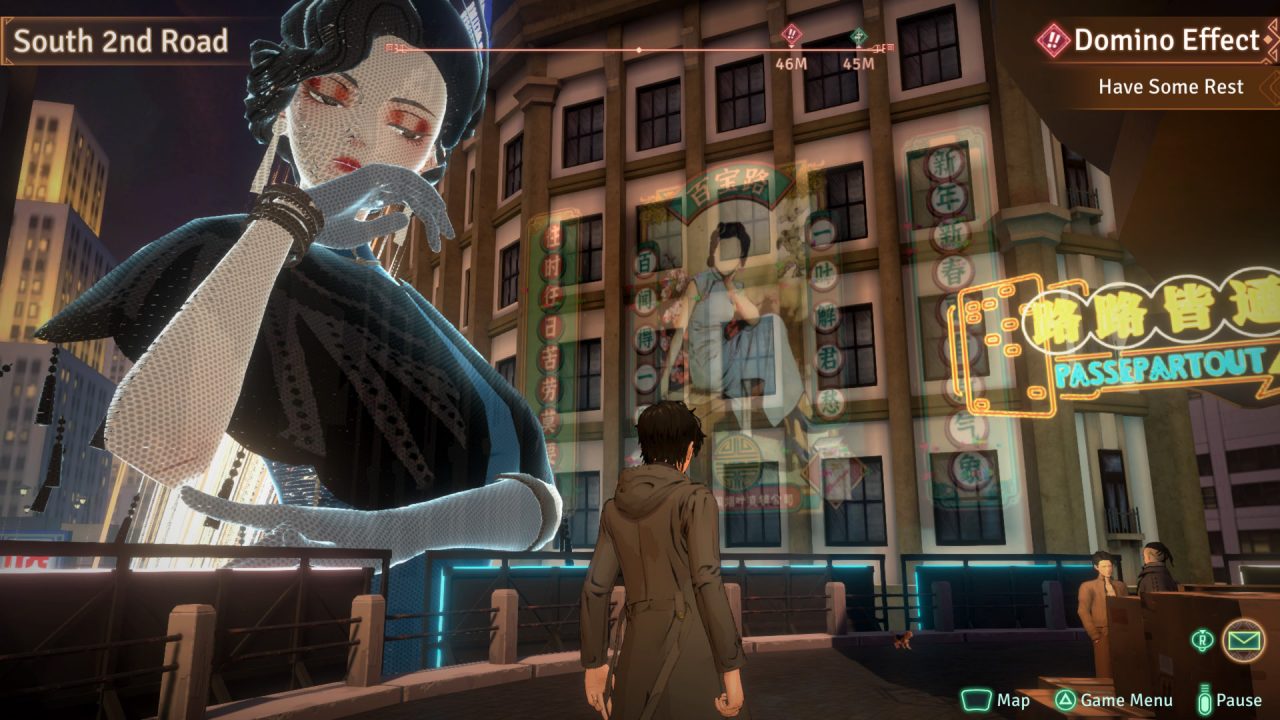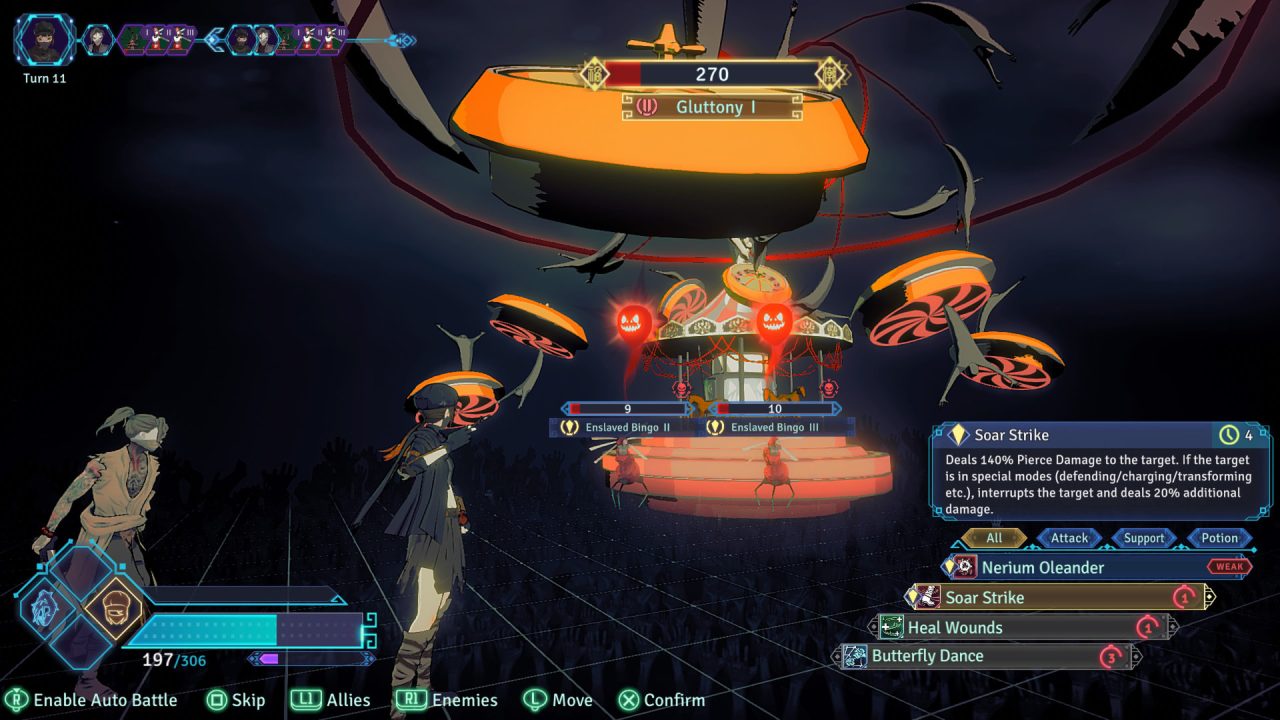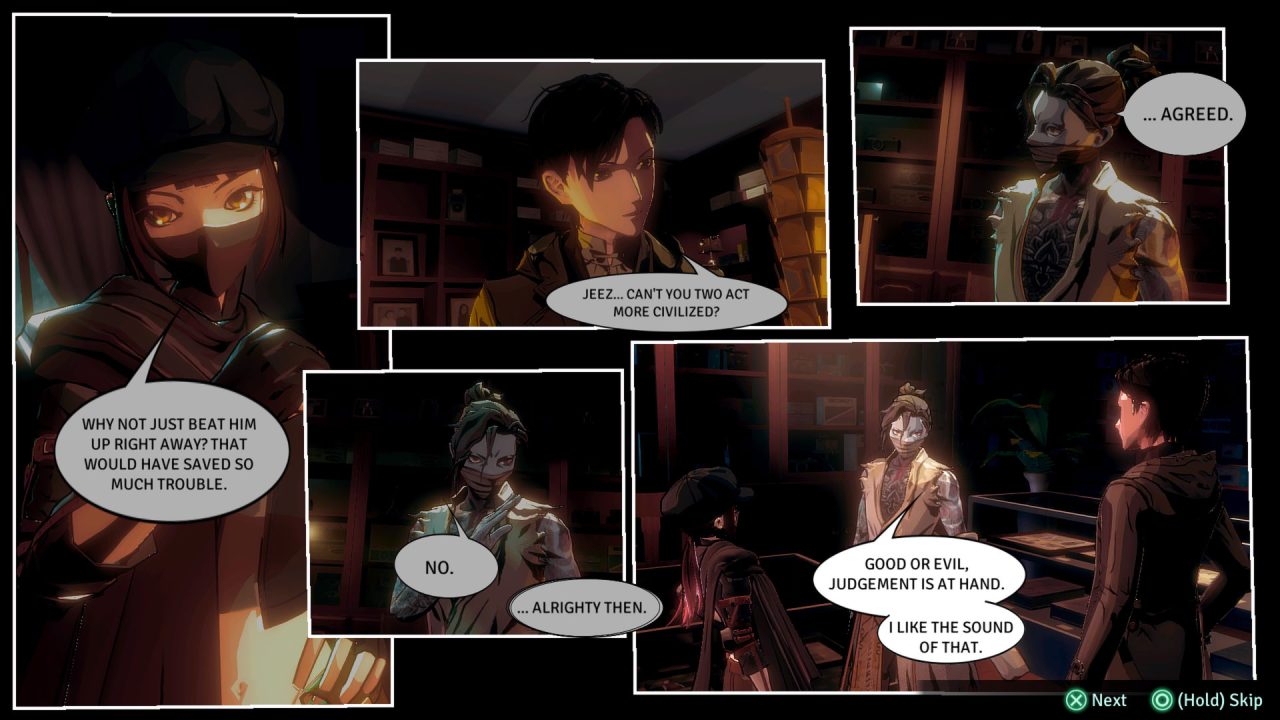Mato Anomalies is a tale of duality. The game switches between two protagonists during pivotal story moments, provides two different-yet-interconnected worlds to explore, and offers two different plots as you progress through the narrative. Most of the time, these converging threads weave together to create an enjoyable tapestry. However, toward the end of the game, the weave unravels under its weight, creating a tangled mess of yarn, which is truly a shame, as a solid RPG experience lies at Mato Anomalies’ core.
Private detective Doe is simply trying to make a living in a mysteriously self-contained futuristic city called Mato when his investigative services are called upon by the enigmatic information broker Nightshade. She wants him to find as much information as possible about an illicit substance called Handout that’s been making the rounds through Mato’s underbelly. No sooner has Doe taken on the assignment than he gets dragged into a strange, nightmarish dimension known as a lair. He’s saved from a gruesome death by a taciturn, scarred swordsman named Gram. Gram and his android companion SkyEye promptly fill Doe in on the situation: lairs are homes to monstrous creatures known as Bane Tide. These monsters occasionally bleed into Mato through inter-dimensional rifts, now appearing at an increased frequency somehow linked to Handout. Doe and Gram’s goals align: Doe is investigating Handout while Gram wants to destroy Bane Tide, and the two agree to a tentative partnership. Doe investigates Mato while Gram takes care of anything supernatural he uncovers. But can their newfound alliance survive when larger conspiracies and bigger mysteries come to light, especially when they threaten not only Mato but reality itself?

Mato as a setting wonderfully fits with an Asian-inspired cyberpunk motif à la such sci-fi noir classics as Blade Runner. A lot of fun is had exploring each new locale of the city that opens up as you play. The city map becomes quite expansive! You’ll encounter various residents, eventually learning how their struggles inexplicably link to rifts and the Bane Tide. While exploring Mato, you control Doe and gather information by talking to people or performing quests. Thanks to help from SkyEye, Doe has access to cyber techniques such as perception sharing, which allows him to see memories from someone else’s perspective. Also, he can Mind/Hack those reluctant to talk to get them to reveal hidden truths. Mind/Hacking is an interrogation that plays like a card game. Specialized decks represent the different personality types of your various party members. Then you “battle” the person you’re questioning, whittling away their resistance. It is an engaging gameplay element, and the different tactical approaches one can take to these sequences are fascinating.
Once Doe finds enough intel on his end, SkyEye helpfully detects a rift location, sending Gram in with the party to clear the newly accessible Bane Tide lair. This portion of the game is similar to the Shin Megami Tensei series, especially the dungeon explorations in the Persona subseries. Lairs have disturbingly otherworldly atmospheres, and Bane Tide’s appearances can be quite unsettling. You-as-Gram traverse the lair, fighting Bane Tide until you reach that stage’s boss. Then you return to Mato, and the investigative cycle repeats until the following rift location is revealed.
Gram and Doe are not alone in their struggles. Aside from the NPC SkyEye’s assistance, a handful of characters also join their investigations for their own reasons. Butterfly is a thief who steals from the corrupt upper class to inspire the oppressed and impoverished workers of Mato, always on the offensive but earnest in her desire to help. Smoker is an older veteran suffering from lingering and horrific trauma in his past, gruff and to the point but also caring. Mist is an electronic idol who shed her physical body and now exists solely on the information network, having to find ways to come to terms with her new existence; she also has a mysterious connection to Nightshade. Lady Edelweiss is the bloodthirsty leader of the Edelweiss gang from one of Mato’s rough areas, always quick to end threats in as destructive a manner as possible. Finally, Ringless is a young messenger of an underground denizen group known as the Rats, who have an eye and ear just about everywhere in Mato, providing Doe with vital information at the most appreciated times. These five make up the remainder of Gram’s battle party and are genuinely compelling characters in their own rights.

Every party member has two types of weapons that they can wield in combat. Smoker is a capable attacker with a handgun and spear, while the gun-aficionado Lady Edelweiss can wield a shotgun or a submachine gun to tear her enemies apart. More often than not, a party member’s available skills come from the weapon type equipped. Because combat skills often connect to weapons, I usually picked a playstyle for a particular character and upgraded that specific weapon type instead of switching things up. For instance, I got so used to Gram’s sword skills and Butterfly’s darts that I never opted to try their other weapon types out. The Bane Tide often have specific weapon weaknesses or resistances, so having a varied four-member party for lair exploration proves beneficial.
Party members share pooled health, levels, and talent points. Whenever a new party member joins, the HP pool for everyone gets that much more extensive. An attack on one character damages everyone, while healing also affects everyone. It puts a unique tactical spin on combat. At first, I thought the shared health would be detrimental to battle, but I quickly learned how to use it to my advantage, especially for healing. Everyone levels up simultaneously with a shared team experience bar, and whenever you acquire a talent or skill point through leveling, each party member gains one to use to strengthen their skill and status tree. The game features a simplistic skill tree system that opens up with higher-level boosts as you unlock them. You can create powerful character builds depending on which abilities you choose to strengthen. You can even unlock new character abilities that aren’t tied to weapon types later on.
The equipment also has levels, with higher-level weapons and grades leading to more skills at your disposal and better stat boosts. You can also equip gears to the party that help bolster stats or abilities for the entire team as an additional form of armor. Generally speaking, you can purchase gears and weapons at stores but also find some extremely high-level equipment in lairs. I often found my go-to weapons by exploring randomly unlocked lairs that you can investigate outside the main story. However, random lairs do have a sanity gauge to keep track of that depletes with every enemy encounter. If it reaches zero, you start combat with debuffs. Buffing and debuffing can also mean the difference between victory and game over in battle, playing a vital part in strategy in the final boss fights. Combat is robust and relatively solid, and the exploration segments in the city and the lairs are enjoyable. Puzzles aren’t overly complicated but may still give you pause.

The beginning and middle portions of Mato Anomalies are compelling. I found the supernaturally tinged sci-fi story entertaining, and the main characters are well-written and likable, with some great dialogue. Unfortunately, at a certain point towards the end of the game, the plot seems to implode on itself and then struggles to recover, never reaching that early momentum again. There was one elegant plot twist, but the final segments dragged on far too long. I’ve never been a fan of those “fake out” endings that exist to prolong a title. In many ways, later reveals in Mato Anomalies cheapen the story built up beforehand, lessening its overall impact. In addition, the finale weakens most of the party members and their story arcs. It isn’t an enjoyable experience because, by that point, you become invested in their stories and the overall landscape of Mato, especially if you are doing all of the immensely story-heavy side quests.
Visually, Mato Anomalies cleverly hides a smaller budget behind some creative presentation choices. Dialogue often plays out with expressive character art and visual novel-style cutscenes. Comic book panel story scenes are utilized instead of full-blown FMVs in many segments, creating a unique look not often seen in RPGs of this ilk. When they do occur, traditional FMVs use the game graphics to a great extent, though the lip-syncing for the game’s English language version is laughable at best. The UI is crisp and readable, with lairs being appropriately otherworldly. Mato is often dark and grimy in less wealthy parts of the city while clean and bright in others. Yet it’s always imbued with neon lights and random bits of stark futuristic technology intermixed with the old. The music sets the atmosphere and tone quite appropriately, and I especially love the song Mist performs if you see her character story through to its conclusion. The English voice acting does the trick quite nicely too. The script itself is localized well, with hardly any errors to speak of.
Mato Anamolies is an appropriate name, as the game is something of an anomaly itself. I want to rate it higher than I have here regarding its overall presentation and solid first and middle narrative portions. Yet the final segments and how they contrast everything that happened beforehand hold me back. It’s frustrating, as I genuinely enjoyed my time with the game in its first two-thirds and could easily see it being a good fit for those looking for a compelling cyberpunk plot or an RPG with a similar tone to Persona. I wouldn’t mind revisiting Mato one day. I hope the next visit’s outcome isn’t so bizarre an unraveled experience.


